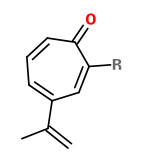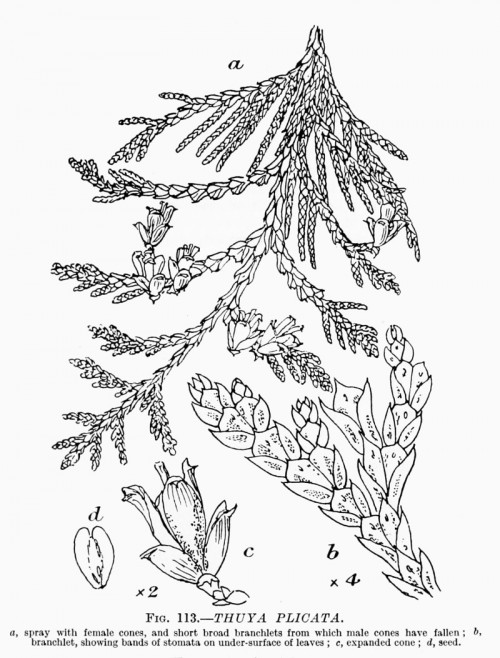Thuja plicata Donn ex D. Don - syn. Thuja gigantea Nutt. - Cupressaceae
western red cedar, Pacific red cedar, giant cedar, canoe cedar, western arborvitae, giant arborvitae, Riesen-Lebensbaum
Evergreen tree, up to 50(-75)m tall, native to western North America; bark reddish brown or grayish brown, fibrous, fissured; crown conical; branches arching; branchlets pendulous; leaves on upper side of branchlets glossy green, lateral leaves longer than facial leaves; pollen cones reddish, 1-3mm, seed cones brown, ellipsoid, 1-1.4cm; seeds reddish-brown, 4-7.5mm (including wings). http://www.efloras.org/florataxon.aspx?flora_id=1&taxon_id=200005457
„Western redcedar has an extensive history of use by the indigenous peoples of the Pacific Northwest Coast, from Oregon to southeast Alaska. Some northwest coast tribes refer to themselves as „people of the redcedar“ because of their extensive dependence on the tree for basic materials.“ Western red cedar (wood cuttings, saw dust) is highly allergenic and 5% of woodworkers or loggers who work with it may have adverse reactions. https://en.wikipedia.org/wiki/Thuja_plicata
The steam-distilled essential oil of T.plicata heart wood contains mainly α-, β- and γ-thujaplicin.
[Antibiotic substances from the heart wood of Thuja plicata D Don; the constitution of alpha-thujaplicin., Gripenberg, J., Acta chemica Scandinavica, 2(8), 1948, 639-643]
[Antibiotic Substances from the Heart Wood of Thuja plicata D. Don.; the constitution of beta-thujaplicin., Anderson, A.B., Grippenberg, J., Acta chemica Scandinavica, 2, 1948, 644-650] http://actachemscand.org/pdf/acta_vol_02_p0644-0650.pdf
 β-thujaplicin (hinokitiol, R=OH)
β-thujaplicin (hinokitiol, R=OH)
The major constituent of the volatile oil of western red cedar leaves was found to be l-thujone accompanied by d-isothujone (~10%). Main hydrocarbons were d-sabinene and car-4-ene. „Smaller amounts of d-α-pinene, d-limonene, d-terpinen-4-ol and an unidentified aromatic ester were also isolated. Trace amounts of α-fenchene, camphene, γ-terpinene, terpinolene, p-cymene and 1,8-cineole were identified by retention characteristics only. The presence of thujyl alcohol and its acetate could not be confirmed.“
[Gas-liquid chromatography of terpenes VI. The volatile oil of Thuja plicata Donn., Von Rudloff, E., Phytochemistry, 1(3), 1962, 195-202]
„Radial distribution of thujaplicins in western red cedar (Thuja plicata Donn) trees of varying ages was studied in order to assess relative decay resistance of their wood… thujaplicins and thujic acid, generally increased from pith to outside heartwood, then decreased in the sapwood. Maximum extractive and thujaplicin contents were also related to tree age. This suggests that products made from the wood of younger trees will be less resistant to decay than similar products made from the wood of old trees.“
[Radial distribution of thujaplicins in old growth and second growth western red cedar (Thuja plicata Donn)., Nault, J., Wood science and technology, 22(1), 1988, 73-80]
Plicatic acid is the major component of the heartwood western red cedar and it is responsible for bronchoconstriction (accompanied by increased levels of histamine and leukotriene E4 in bronchial mucosa) in patients with red cedar asthma.
[Histamine and leukotrienes release in bronchoalveolar fluid during plicatic acid-induced bronchoconstriction., Chan-Yeung, M., Chan, H., Tse, K.S., Salari, H., Lam, S., Journal of allergy and clinical immunology, 84(5), 1989, 762-768]

Giant Arbor vitae, Dallimore,W., Bruce,A., A handbook of Coniferae, p.519, fig.113 (1923) [G.Lister]
http://plantgenera.org/species.php?id_species=1014336